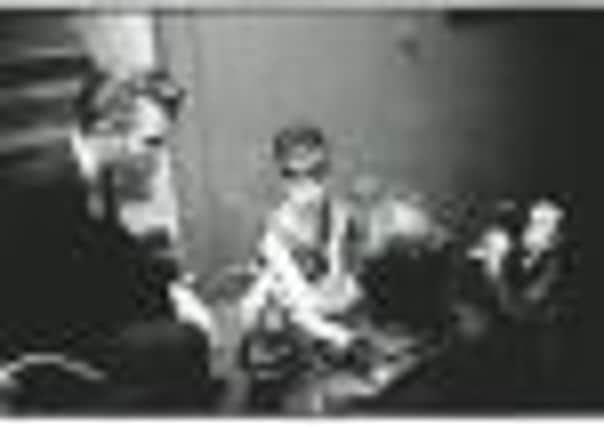Visual art review: Alan Dimmick: Photography From The Last 15 Years of Contemporary Art in Scotland, GoMA, Glasgow


When Alan Dimmick started taking photographs documenting exhibitions at Transmission Gallery in the mid 1990s, he was in the right place at the right time. The not-yet-famous generation of Scottish artists who had left Glasgow School of Art around the turn of the decade were having their first major shows, playing in bands, helping with artist-run spaces. Dimmick was in on the ground floor of what would later be called the “Glasgow miracle”.
He continued to photograph the art scene in Scotland, particularly Glasgow, in the decades that followed, though without any sense of exploiting its growing notoriety. His photographs (he chronicled the indie music scene as well as the art scene) are rarely exhibited, and remain a quietly important record of a key period in Scottish cultural history.
Advertisement
Hide AdAdvertisement
Hide AdIn this show, which concentrates on art, we see an early exhibition at Transmission by future Turner Prize-winner Simon Starling; Franz Ferdinand’s Alex Kapranos hanging out at Glasgow School of Art in 1996; a performance by Elizabeth Go, the collective featuring sisters Hayley and Sue Tompkins, Sarah Tripp, Victoria Morton and Cathy Wilkes; Toby Paterson winning the Becks Futures Prize; and Roddy Buchanan’s stag party, when he married fellow artist Jackie Donachie.
The images, not always striking in themselves, are important in the world they show us: a scene gradually evolving; changing faces, haircuts and fashions; wet-behind-the-ears graduates maturing into confident professionals; relationships forming, children being born. Important works are recorded – children capering on a Jim Lambie floor, or playing peekaboo behind the giant letters of Joanne Tatham and Tom O’Sullivan’s Heroin Kills; Hidden Gardens when it was just a stretch of wasteland behind Tramway.
Then there are the places where it all happened: it’s poignant to see a crowd on the pavement outside an opening at Sorcha Dallas, and a queue for a gig at the Lighthouse, both now closed; a morning-after-the-party shot from the Chateau, sunlight from high windows illuminating a debris of discarded beer bottles; “Ian the lift man” at 73 Robertson St, former home of the Modern Institute, a face held in affection by many in Scottish art.
The social fabric of the art scene, particularly in Glasgow, is almost inseparable from professional developments, as evidenced by the title of Sarah Lowndes’ book on the subject, Social Sculpture. Dimmick, while keeping his distance behind his lens, has been allowed under the surface of that world in a way that many photographers have not, because of his friendships with many of the artists.
He can, therefore, show them at ease, and this is where the work really shines: Karla Black and Cathy Wilkes, both notoriously pricky in terms of media engagement, laughing together and playing with one of Wilkes’ children; Jim Lambie in full Highland dress on the way to a wedding; Lucy McKenzie dancing at the 13th Note; Claire Barclay with a cat on her shoulders; pregnant Jackie Donachie showing off her bump. The photographs deliberately taken as portraits are less interesting. Here the artists are back on their guard, hiding behind serious expressions or deliberately wacky poses. These would benefit from being grouped separately, as would the pictures which chronicle a particular event, like the filming of Roddy Buchanan’s seminal work, Gobstopper.
This exhibition – over 300 black and white prints pinned to the wall with scribbled captions in seemingly unordered collages – would benefit from more selection and presentation. There are too many pictures of people standing around at openings, awkwardly holding bottles of beer; too many captions which don’t tell us the names, places or dates.
But this is the challenge of an archive such as this one. It was the same with the Harry Papadopoulos photographs of the music scene shown last year at Street Level for the first time, and the issues are multiplied several times over in the Richard Demarco Archive, which now spans 50 years and millions of photographs, some of which are art historical gems. Only careful sifting and meticulous labelling will ensure that the gold – that key moment when X met Y, the beginning of the collaboration or the marriage or the fight – stands out from the other run-of-the-mill shots of barely remembered parties.
Advertisement
Hide AdAdvertisement
Hide AdA mistake sometimes made with candid photography is the assumption that it can tell its own story without any help. In fact, it needs to be drawn out, particularly for those with only a glancing familiarly with people and events portrayed. Pictures of people socialising, rather than inviting the viewer in, tend to exclude. There is an important story to be told here about the rise and rise of contemporary art in Scotland – the danger is that it can all begin to feel like a great party you happened to miss, and can’t possibly understand because you weren’t there.
Rating: ***
• Until 13 May